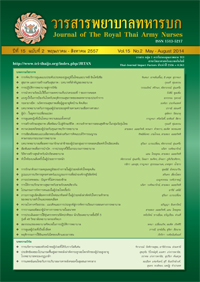การรักษาด้วยการลดอุณหภูมิของร่างกายในผู้ป่วยหลังหัวใจหยุดเต้น Therapeutic Hypothermia after Cardiac Arrest
Keywords:
การรักษาด้วยการลดอุณหภูมิของร่างกาย, ลดอุณหภูมิของร่างกาย, หัวใจหยุดเต้น, Therapeutic Hypothermia, Hypothermia, Cardiac arrestAbstract
ภาวะหัวใจหยุดเต้นเป็นสาเหตุสำคัญที่ทำให้สมองของผู้ป่วยเกิดภาวะขาดเลือดและออกซิเจน ผู้ป่วยที่รอดชีวิตหลังหัวใจ หยุดเต้นมักประสบกับปัญหาสมองสูญเสียการทำงาน เกิดภาวะทุพพลภาพ ซึ่งการรักษาผู้ป่วยภายหลังหัวใจหยุดเต้นเมื่อมีการคืนกลับของระบบไหลเวียนโลหิตแล้ว ด้วยการลดอุณหภูมิของร่างกายผู้ป่วยนั้นมีประสิทธิภาพลดอัตราการตายและฟื้นฟูการทำหน้าที่ของเซลล์สมอง ระดับอุณหภูมิที่เหมาะสมในการรักษาผู้ป่วยคือ 32 - 34 องศาเซลเซียส เป็นเวลานาน 12 - 24 ชั่วโมง โดยแบ่งขั้นตอนการรักษาออกเป็น 3 ช่วง คือ ช่วงการชักนำสู่อุณหภูมิเป้าหมาย ช่วงรักษาอุณหภูมิและช่วงเพิ่มอุณหภูมิแกนกลางให้กลับสู่ปกติ การรักษาด้วยการลดอุณหภูมิของร่างกายมีความจำเป็นต้องอยู่ภายใต้การดูแลของพยาบาลวิกฤตที่มีความรู้ ความเชี่ยวชาญ สถานที่รักษาที่มีอุปกรณ์ทางการแพทย์ที่เหมาะสมต่อการติดตามการเปลี่ยนแปลงของผู้ป่วย ตลอดจนการเฝ้าระวังภาวะแทรกซ้อนที่อาจจะเกิดขึ้นในระหว่างการรักษา เพื่อให้การรักษาเกิดประสิทธิภาพสูงสุดต่อผู้ป่วย
Cardiac arrest is a major cause of death and brain anoxia among the survival patients, commonly leading to neurological impairments and disability. Therefore, therapeutic hypothermia has been introduced recently as the intervention is demonstrated to decrease mortality rate and improve neurological recovery in patients after cardiac arrest with the return of spontaneous circulation (ROSC). The target of core body temperature is 32-34 degree celcius and maintain at the range for 12-24 hours. There are 3 phases of therapeutic hypothermia: initiation, maintenance and rewarming. All patients receiving the treatment should obtain close monitoring and intensive care by experienced professional nurses. It also requires specifi knowledge, competencies and medical equipments for early detection of any potential complications in order to maximize the intervention’s effectiveness and patients outcomes.
Downloads
How to Cite
Issue
Section
License
บทความหรือข้อคิดเห็นใดใดที่ปรากฏในวารสารพยาบาลทหารบกเป็นวรรณกรรมของผู้เขียน ซึ่งบรรณาธิการหรือสมาคมพยาบาลทหารบก ไม่จำเป็นต้องเห็นด้วย
บทความที่ได้รับการตีพิมพ์เป็นลิขสิทธิ์ของวารสารพยาบาลทหารบก
The ideas and opinions expressed in the Journal of The Royal Thai Army Nurses are those of the authors and not necessarily those
of the editor or Royal Thai Army Nurses Association.





